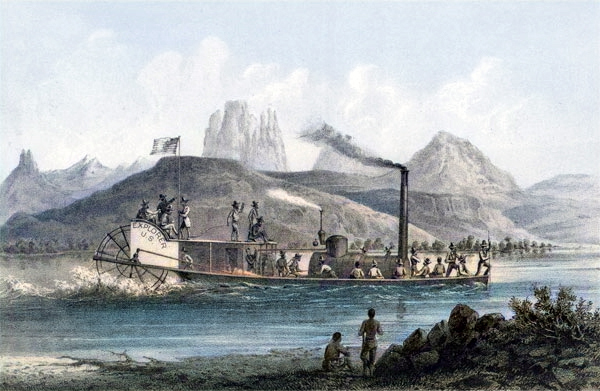https://mojavedesert.net/steamboats/colorado-steamboats.html
Steamboats on the Colorado River played a significant role in the development of the American West during the 19th and early 20th centuries. They were primarily used for transporting goods and people up and down the river, a critical artery for accessing the remote regions of the Mojave Desert, Arizona, and southern California.

The Era of Steamboats:
- Beginnings: Steamboat navigation on the Colorado River began in earnest in the 1850s. The first successful steamboat to navigate the river was the “Uncle Sam” in 1852, which marked the start of steamboat commerce until the early 1900s.
- Key Ports: Important ports along the river included Yuma (Arizona Territory), which served as a central distribution point for supplies to military posts in the region, settlements, and mining operations in areas like the Gila River the Mojave Desert and upriver to places like Callville and Rioville in Nevada.
- Navigation Challenges: Navigating the Colorado River was notoriously difficult due to its unpredictable water flow, shifting sandbars, and snags. Boats with shallow drafts and powerful engines were necessary to handle these obstacles.
Impact and Decline:
- Economic Impact: Steamboats on the Colorado River were crucial for the economy, particularly in supporting mining operations. They transported silver, gold ore, other minerals, and goods and supplies to isolated settlements.
- Decline: The arrival of railroads in the late 19th century gradually led to the decline of steamboat traffic on the river. Railroads provided a more reliable and quicker means of transportation and could operate year-round without being affected by the river’s water levels.

The Explorer (colorized)
Legacy:
- The steamboats of the Colorado River are an essential part of the history of transportation and commerce in the American Southwest. They contributed to the region’s economic development and helped shape the settlements along the river. Today, they are remembered through historical markers, museum exhibits, and river tours that explore their history.
Steamboats represent a fascinating chapter in the history of the American West, highlighting the adaptability and ingenuity required to tame such a challenging and vital waterway.